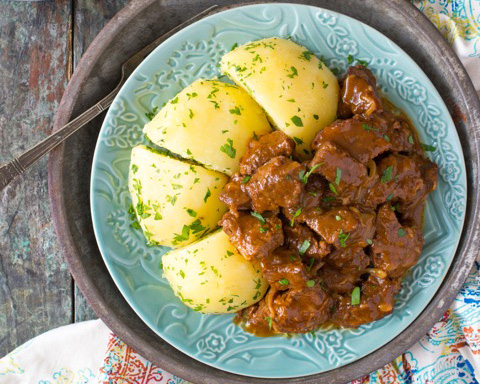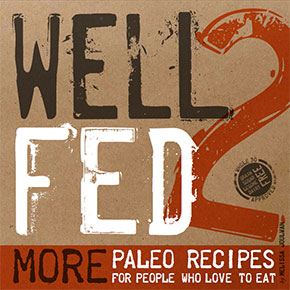In each issue of Paleo Magazine, I share the history of a traditional recipe and adapt it to fit into a healthier paleo lifestyle. In this...
Read MoreHungarian Goulash & Potatoes
In each issue of Paleo Magazine, I team up with Steph Gaudreau to share the history of a traditional recipe and adapt it to fit into a healthier paleo lifestyle. (I write the words; she makes the gorgeous photos.) In a previous column, we followed the trail of paprika from Mexico to the Ottoman Empire and the banks of the Danube River to discover the true taste of Hungary.

Hungary for Goulash
We Americans have gotten paprika and goulash all wrong.
Before I became infatuated with world cuisine, I thought paprika was just the red stuff you sprinkled on deviled eggs to give them a little color—and goulash was basically glorified Hamburger Helper, a soupy concoction of elbow macaroni, ground beef, and tomato sauce.
Then, in a pub almost hidden down a cobblestoned alley in a Medeival town, I ate a traditional goulash, made with wild boar that had been simmered until it fell apart into tender, bite-sized morsels. The sauce was richly seasoned with Hungarian paprika: delicate and fruity with a subtle smokiness and a mild bite at the back.
Paprika is made from air-dried chili peppers (Capsicum annuum, specifically), and it’s native to central Mexico. Thanks to the shenanigans of Spanish traders and Ottoman conquerors, paprika was eventually cultivated by Turks on the hills of Buda, now half of the Hungarian capital of Budapest. The climate and soil of Hungary, fed by the Danube River, produce paprika that is redder and sweeter than anywhere else in the world.
Paprika is used in traditional cuisines in countries across the globe—Morocco and other north African countries, Turkey, the Balkans, the Americas—to add flavor and color to rice dishes, stews, soups, and sausages. But no other dish better represents and defines paprika than Hungarian goulash.
From the Middle Ages until the 1800s, the grasslands in the southern and eastern parts of Hungary, known as the Puszta, were the home to substantial herds of cattle. Herdsmen known as gulyás drove the stock north and west to Venice, Nuremberg, and Vienna. Along the way, they nourished themselves with stew made from their beef, simmered with paprika, garlic, caraway seed, and bell peppers in a big pot over an open fire.
By the end of the 19th century, wars and politics led Hungarians to cling to their native Magyar traditions and goulash moved from the cattle drive to the dining room. This peasant dish became a sensation, and it’s popularity spread throughout the Austrian-Hungarian empire. Each culture added its own twist: In Italy, it’s served with polenta. In Czech and Slovak pubs, the goulash plate isn’t complete without dumplings. And here in the United States, the paprika was diminished and elbow macaroni was mixed in to create what’s sometimes known as slumgullion.
Our Paleo-friendly recipe is a Hungarian adaptation, and we’ve included tips for other variations. But before you can start cooking, you must get serious about paprika.
You probably have a tin or jar of paprika languishing in your spice cabinet right now. It may have a red-green-and-white Hungarian flag on the label, and you may have sprinkled it on a roast chicken recently. Sadly, your paprika must go. Toss it in the trash… now.
Before attempting this or any recipe with paprika as the star, you must buy a fresh supply of true Hungarian paprika. You owe it to yourself and the history of Magyar cuisine! All spices gradually lose their potency, but paprika is particularly vulnerable to the ravages of time. Fresh paprika will taste bright and sweet, like sunshine and adventure. (Feel free to replace the beef and pork listed in the recipe with wild boar if you’re fortunate enough to find it.)

Hungarian Goulash
Serves 4 | Prep 20 minutes | Cook 90 minutes
Ingredients:
Goulash:
1/4 cup arrowroot powder or potato starch
2 teaspoons salt
1/2 teaspoon ground black pepper
1 1/2 pounds beef chuck or pork shoulder, trimmed and cut into 1-inch cubes
1 tablespoon ghee
2 medium onions, peeled and thinly sliced
2 tablespoons sweet Hungarian paprika
1 teaspoon caraway seeds
2 cups beef bone broth
1 tablespoon fresh lemon juice
Potatoes:
4 medium potatoes, peeled and cut into 2-inch dice
1 tablespoon salt
water
1 tablespoon ghee
1/4 cup fresh parsley, minced
Directions:
Start the meat. In a bowl, combine the arrowroot, salt, and pepper; add the beef and toss to coat the cubes. Melt the ghee in a large soup pot over medium heat. Add the beef in a single layer and cook until it has a nice crisp crust, about 10 minutes. Remove the beef from the pot and add the onions to the pot. Cook the onions, stirring frequently, until wilted, about 10 minutes. Add the paprika and caraway seeds and stir for 1 minute.
Braise the meat. Return the beef to the pot. Add 1/2 cup of the broth, stirring and scraping the bottom of the pot. Gradually stir in the remaining broth. Bring to a boil, then reduce heat to a slow simmer. Cover and cook until the beef is tender, about 1 1/2 hours.
Cook the potatoes. About 30 minutes before the goulash is finished simmering, place the potatoes in a saucepan with the salt and add enough water to just cover the potatoes. Bring to a boil, then simmer until tender, about 20 minutes. Drain the potatoes and return to the pan. Add the ghee and parsley; gently toss with a rubber spatula to coat the potatoes.
Big finish! Remove the lid from the goulash, stir in the lemon juice, and taste to see if the stew needs more salt and pepper. To serve, place potatoes and goulash in a bowl and top with additional parsley.
You Know How You Could Do That?
Austrian-style: add a fried egg to the top of each serving
Croatian-style: add porcini mushrooms before simmering
Czech-style: serve with thinly-sliced raw white onion
Hungarian variation: add sauerkraut to the goulash pot when you start the potatoes
For more delicious recipes like this one, subscribe to Paleo Magazine.
Still hungry? Try these
In each issue of Paleo Magazine, I team up with Steph Gaudreau to share the history of a traditional recipe and adapt it to fit into a...
Read More




This looks TOTALLY delicious! I’m adding it to my menu right now. Curious…do you think this could be made in a slow cooker or pressure cooker? If so, how would you recommend doing that?
Also…I’ve been cooking your recipes for several months now, both on the website and from your books. Every single recipe I’ve made has been absolutely amazing! Not only has my belly been totally happy, but I think my man loves me even more (since he’s the other recipient of these meals)…how awesome is that!?!?
Thanks for making us “well fed” and happy 🙂
I don’t have an Instant Pot or pressure cooker, so I’m zero help there, but this post from the NYTimes looks pretty awesome:
https://www.nytimes.com/2017/01/31/dining/how-to-convert-recipes-for-a-pressure-cooker.html?mcubz=3&_r=0
I think it will be soupy and not get the slow-braise-evaporation-magic that happens on the stovetop if you make it in a slow cooker, but if you want to try it, reduce the beef broth to 1 cup, and cook it for 4-6 hours (?). Simmer with the lid off the slow cooker for the last 30 minutes.
Thank you for responding. I’ll make it your way (which I’m sure will turn out great) and then next time I might try it in a slow cooker. It looks like someone else did that and had success…YAY!!!!
PS…I enjoyed reading about the origin of paprika and this dish…great info!
Great timing – I will be having the authentic goulash (gulyas) in just a few days!
Sounds yummo, perfect comfort food for the cooler days that are settling in!
I shamelessly used ground beef because it needed to be eaten, but this is amazing and delicious! (and with ground beef, it came out beautifully in my slow cooker). Also protip: ghee-poached sous-vide potatoes FTW. 😉
It’s like American goulash made with ground beef. I love it!
This looks wonderful! My husband and I used to share a house with a Hungarian man who occasionally made a big pot of goulash for special occasions. And, yes, he actually cooked it all day over a fire in the garden! Sadly his recipient was kept a secret. I look forward to trying your version,. Thanks.
I love the flavor of this stew – the caraway seed gives it a unique punch. Easy to make. I added cooked carrot, potatoes and mushrooms into the pot when the meat was done cooking and ate it as a stew. Thank you for sharing your recipes – they’ve added a whole new dimension of flavor to my Whole30 eating.
Those sound like delicious mods! Glad you liked it!
If you really want to make it good, cook the potatoes with the meat – just throw them into the pot 30 mins before the meat is done. And – Hungarians never serve goulash with sauerkraut. That is a different dish…
Another win in our book! My husband said to “add it to the rotation”- which means this is so good he wants it every week! Thanks again!
That American goulash/chop suey that we had in New England school lunches? I found out in California they call it slumgullion. This sounds much better!
SLUMGULLION! What a name!
This seems so complicated compared to the stuff I grew up on (my father was born in Hungary). The way my mother was taught to make it was sauté an onion in bacon fat, add and brown the meat cubes. Add paprika, a small can of tomato sauce and water to cover. 45 minutes before meat is done, add cubed potatoes. And that’s it. That is apparently the peasant-style version of the dish.
Most traditional recipes have a bajillion variations because home cooks make it their own way. I love that!
Just finished making this and it was delicious!!! My girlfriend and I loved it. I served it with a side of your oven roasted cauliflower recipe and it was so good and so special. Looking forward to trying more of your recipes… thank you for sharing!!
That’s awesome! I’m glad you enjoyed it, and I hope you felt like you were transported to Budapest 😉
We absolutely love this recipe. What paprika would you suggest?
I don’t have a recommendation for a specific brand, if that’s what you’re asking. Any brand will do, as long as it’s fresh. You want sweet, not hot, and the fresher the better. Hungarian, if possible. I love Penzey’s spices, and they’re a great, family-owned company. Their paprika is great: https://www.penzeys.com/online-catalog/hungarian-style-sweet-paprika/c-24/p-1141/pd-s